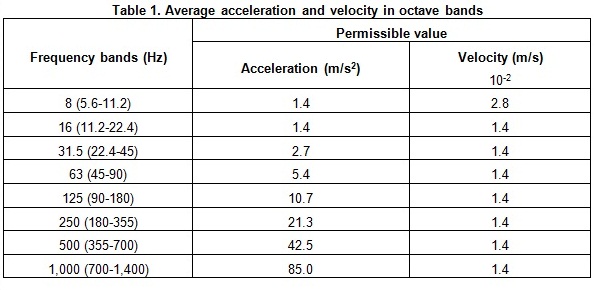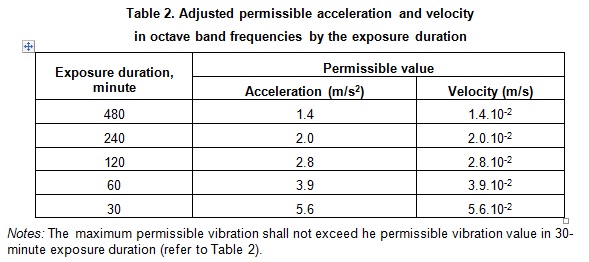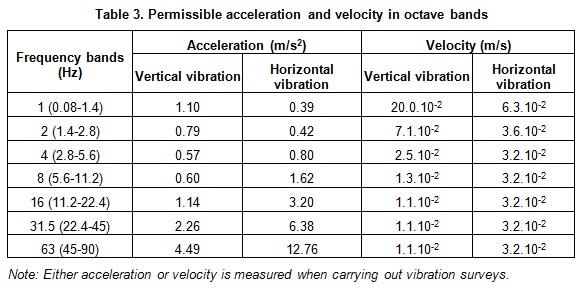Permissible Levels of Vibration in the Workplace
Permissible vibrations are determined by a perpendicular coordinate system attached to human body. A perpendicular coordinate system has 03 axes:
z- Vertical axis, perpendicular to the ground, from the human foot to head
X – Horizontal axis, from the human back to chest.
y- Horizontal axis, from the right shoulder to the left shoulder
1. Hand-Arm vibration
Permissible acceleration and velocity in a range of frequencies are presented in table 1.

Adjusted permissible acceleration and velocity in octave band frequencies depends on the exposure duration and are presented in Table 2

Adjusted permissible acceleration and velocity: Within 8 hours (480 minutes) of contact, the adjusted velocity and acceleration of vibration at other frequency bands shall not exceed 4 cm/s and 4m/s2, respectively.
Adjusted permissible acceleration and velocity by exposure duration:Where the exposure duration is less than 8 hours per day, the adjusted permissible acceleration and velocity shall be determined by the following function:

Where:
ahD: the adjusted value (the adjusted permissible velocity or acceleration by exposure duration (t))
ah: the adjusted permissible velocity or acceleration within 08 hours (480 minutes) of working duration.
T: Actual exposure duration, expressed in minute.
The maximum adjusted acceleration and velocity shall not exceed 16m/s2 and 16cm/s, respectively, within 30 minutes of working.
2. Whole-body vibration
Permissible acceleration and velocity in octave band frequencies are presented in table 3.

The adjusted permissible acceleration of vertical vibration (by z axis) and horizontal vibration (x and y axes) shall not exceed 0.54m/s2 and 0.38 m/s2, respectively.
Different tools and workplace have different acceleration adjusted coefficient by exposure duration.
Type 1: Transportation vibration to which workers at mobile machinery and means of transport are exposed. E.g.: Drivers of trucks and agricultural tractors…
The adjusted permissible acceleration by exposure duration equals (=) the adjusted acceleration multiplied by (x) 1. The adjusted permissible acceleration of vertical vibration (by z axis) and horizontal vibration (x and y axes) shall not exceed 0.54m/s2 and 0.38 m/s2, respectively.
Type 2: Transportation vibration – technology affecting workers in the workplace having machinery and means of transport in a limited area of a production area or mining site. E.g.: Operators of cranes, excavators and mining machines.
The adjusted permissible acceleration by exposure duration equals (=) the adjusted acceleration multiplied by (x) 0.5. The adjusted permissible acceleration of vertical vibration (by z axis) and horizontal vibration (x and y axes) shall not exceed 0.27m/s2 and 0.19 m/s2, respectively.
Type 3: Vibration caused by production activities affecting workers in the location of static machines or transmitting or the workplace where no source of vibration is located. E.g. operating tools and ground of fixed machines used in production
The adjusted permissible acceleration by exposure duration equals (=) the adjusted acceleration multiplied by (x) 0.16. The adjusted permissible acceleration of vertical vibration (by z axis) and horizontal vibration (x and y axes) shall not exceed 0.086m/s2 and 0.06 m/s2, respectively.
Every facility whose workers contact with vibration shall periodically measure vibration levels in the workplace at least once a year and shall comply with the Labor Code and the Law on Occupational Hygiene and Safety.
Employers shall provide sufficient personal protective equipment which is useful in the working environment for their employees.
If the vibration level in the workplace exceeds the permissible value, the employer shall take measures for improving the working environment and protecting employees’ health.
The adjusted permissible acceleration of vertical vibration (by z axis) and horizontal vibration (x and y axes) shall not exceed 0.54m/s2 and 0.38 m/s2, respectively.
Different tools and workplace have different acceleration adjusted coefficient by exposure duration.
Type 1: Transportation vibration to which workers at mobile machinery and means of transport are exposed. E.g.: Drivers of trucks and agricultural tractors…
The adjusted permissible acceleration by exposure duration equals (=) the adjusted acceleration multiplied by (x) 1. The adjusted permissible acceleration of vertical vibration (by z axis) and horizontal vibration (x and y axes) shall not exceed 0.54m/s2 and 0.38 m/s2, respectively.
Type 2: Transportation vibration – technology affecting workers in the workplace having machinery and means of transport in a limited area of a production area or mining site. E.g.: Operators of cranes, excavators and mining machines.
The adjusted permissible acceleration by exposure duration equals (=) the adjusted acceleration multiplied by (x) 0.5. The adjusted permissible acceleration of vertical vibration (by z axis) and horizontal vibration (x and y axes) shall not exceed 0.27m/s2 and 0.19 m/s2, respectively.
Type 3: Vibration caused by production activities affecting workers in the location of static machines or transmitting or the workplace where no source of vibration is located. E.g. operating tools and ground of fixed machines used in production
The adjusted permissible acceleration by exposure duration equals (=) the adjusted acceleration multiplied by (x) 0.16. The adjusted permissible acceleration of vertical vibration (by z axis) and horizontal vibration (x and y axes) shall not exceed 0.086m/s2 and 0.06 m/s2, respectively.
Every facility whose workers contact with vibration shall periodically measure vibration levels in the workplace at least once a year and shall comply with the Labor Code and the Law on Occupational Hygiene and Safety.
Employers shall provide sufficient personal protective equipment which is useful in the working environment for their employees.
If the vibration level in the workplace exceeds the permissible value, the employer shall take measures for improving the working environment and protecting employees’ health.
QCVN 27:2016/BYT replaces the standard on vibration included in the standard on occupational hygiene issued under the Minister of Health’s Decision No.3733/2002/QD-BYT dated October 10, 2002.
(Nguồn tin: Vnniosh.vn)
